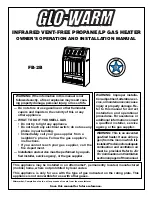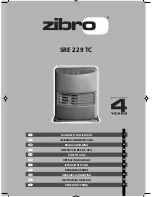
13. Multiple manifold cylinders may be required to ensure continuous supply of gas.
14. When the heater is to be stored indoors, the connection between the propane gas supply cylinder(s) and
the heater must be disconnected and the cylinder(s) removed from the heater and stored in accordance
with the Standard for the Storage and Handling of Liquified Petroleum Gases, ANSI/NFPA 58 or Standard
CSA B149.1 Natural Gas and Propane Installation Code as appropriate.
15. The heater must be located at least 6 ft . (1.83 m) in the U.S.; or 10 ft . (3 m) in Canada from any propane
gas container.
16. Propane gas supply containers have left handed threads. Use the manual hand wheel supplied with the
regulator to make a connection of the regulator’s P.O.L. fitting into the cylinders’ gas supply valve.
17. Use pipe joint compound that is approved for use with propane gas.
18. For either indoor or outdoor installation. Adequate ventilation shall be provided in accordance with
OSHA 29 CFR 1926.154, Safety Requirements for Temporary and Portable Space Heating Devices and
Equipment, ANSI A10.10, National Fuel Gas Code, ANSI Z223.1/NFPA54, Liquified Petroleum Gas Code,
NFPA 58 or the Natural Gas and Propane Installation Code, CAN B149.1, as appropriate.
GENERAL OPERATING INSTRUCTIONS
1. Read all safety precautions when installing this heater. If during the installation or relocating of heater, you
suspect that a part is damaged or defective, call a qualified service agency for repair or replacement.
2. The heating equipment must be properly positioned before use on a flat, stable, and horizontal surface.
Ensure the heater is level. (Use a level, check lengthwise & crosswise). Observe and obey all minimum
safe distances of the heater to the nearest combustible materials. Safe distances are given on the heater
dataplate and on page 4 of this manual.
3. L.P Gas Installation Requirements
• Ensure all L.P. gas containers are secured and protected from all people, vehicular traff ic and contact.
• L.P. gas containers must be located on a flat,level, and stable surface.
• L.P. gas cylinders must be secured from tip-over.
Contact your local authorities, L.P. gas dealers, or fire marshalls for specifics dealing with installation in your
area.
4. The heater’s gas pressure regulator must be protected from adverse weather conditions (rain, ice, snow)
12














































